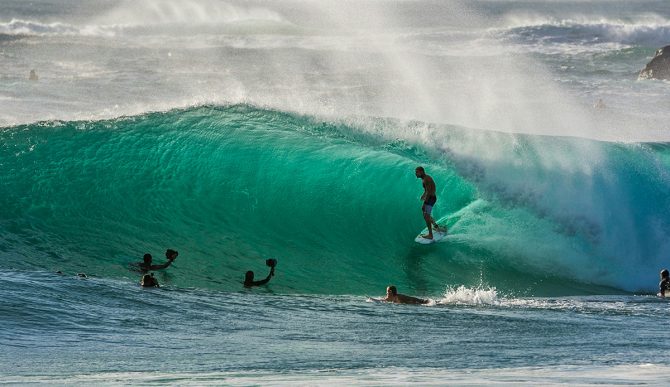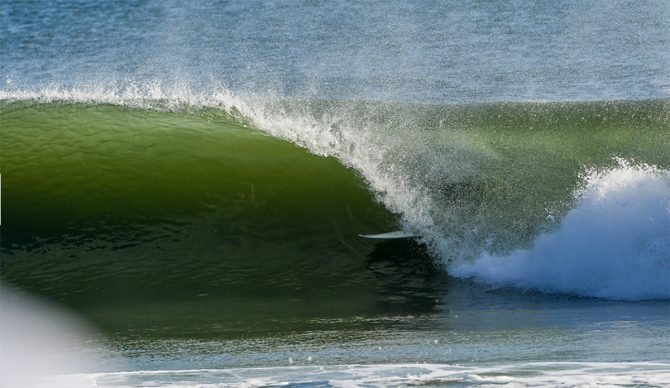
What’s the big deal with the barrel? Mick knows. Photo: Brandon Compagne
Lately I’ve been thinking, why do we make such a big deal about the barrel? It’s not like it’s everybody’s favorite thing about surfing. Truth is, relatively few surfers ever get to experience an actual barrel ride. Yet, judging by so much of the content of today’s surf media, the sport seems more obsessed with that particular aspect of wave-riding than ever before. Slabs? All about the barrel. Surf travel and exploration? All about the barrel. Big wave riding? All about the barrel. Even wave pools — nobody is paying $3,000 a day at Lemoore (or Abu Dhabi) to do a series of turns, and despite what you might hear from of a handful of sponsored pros, no civilian surfer gives a damn about the “air” section at any of the new shorebreak kiddie pools.
No, from three foot to 30 (and at breaks like Peahi and Mullaghmore make that 50) it’s all about getting in the barrel. And it can’t just be, “Hey, it’s all about the rush, man.” Mason Ho gets barreled off his brain at big Pipe, but still regularly risks his neck pulling into tiny tubes over dry lava. Face it, when it comes to the barrel, there must be something pretty special going on in there.
It’s difficult to point, exactly, to where the whole barrel thing got started. Initial flirtation with the curl began in the 1940s with widespread acceptance of the surfboard fin. Freeing surfers from having to simply slide to shore on the shoulder, this revolutionary new directional device allowed them to ride on the wave’s steeper portions, closer to the breaking curl. Exploration of this new territory throughout the 1950s and early 1960s eventually led to the “head dip,” a somewhat ridiculous move in which surfers would position themselves close enough to the curl to have it break on their lowered heads (still performed today by many intermediate skill level longboarders), and later, getting “locked-in,” which saw tuned-in surfers effectively positioning themselves in the curling portion of the wave, if not fully behind it.
So far as my research goes, the first depiction of an honest-to-god, “I did this deliberately” tube ride can be found in Bruce Brown’s 1965 classic documentary The Endless Summer. So much better known for his Cape St. Francis segment, in which out of whole cloth Brown created the myth of “the perfect wave,” in one of the film’s earlier sequences Brown makes another potent declarative statement. In a brief, two-wave sequence in which Island surfer Wayne Miyata is shown riding a short, hollow wave called “Garbage Hole,” by swinging in behind it’s three-foot peak, getting completely covered by the curl and emerging cleanly on the shoulder, Miyata is described by Brown as doing surfing’s “ultimate thing.”
Weird, how even though Miyata showed us that it could be done, with his ride described as being the “ultimate thing,” the barrel didn’t catch on right away. Apparently, we still had the noseriding era to get through (1963 to 1966), followed by the “high-performance” period (1967 to early 1968) which eventually led to the vaulted “Shortboard Revolution” (1968 to 1970).

In New Jersey barrels are certainly a thing. Photo: Tim Torchia
Hat’s off to eccentric Santa Barbara kneeboarder George Greenough for leading us back into the tube, not only with his groundbreaking performances but his uber-innovative, wide-angle POV cinematography, which in his film Innermost Limits of Pure Fun, gave surfing audiences their first glimpse of what it really looked like inside the “green room.” But it wasn’t until winter of 1970-71, when a young Gerry Lopez first strapped a wickedly narrow pintail to the roof of his VW and made the drive north through Wahiawa, over the Haleiwa Bridge and out to Ehukai Beach Park, that everything changed. During the course of a single season, Lopez, with his newly-refined act at Pipeline, took Brown’s simple statement and made it a manifesto. Not only was the barrel now fully accepted as the ultimate thing, but within only a few years an even more impactful amalgamation of the Endless Summer’s two declarative creeds would become pervasive. Now for a wave to be deemed perfect, it had to be a barrel.
And so here we are today, over a half century later, and not only has nothing supplanted the barrel as the ultimate in surfing — don’t even talk to me about aerials — but the barrel ride has shown it still has juice enough to continue dramatically shifting paradigms. Ask yourself this: what do you see when you picture the surfing of current WSL World Champion, young Caity Simmers? Her aerial reverses, or her full-bore barrels at Pipe and that crazy drainer in the Cape Verde Islands? No, there’s still something happening back in there that drives surfers to enjoy surfing, love it, even….but only dream of one thing.
Turns out, there are scientists and researchers who actually study what goes in inside a breaking wave, and I figured it was worth seeing what they had to say. A bit of Googling brought me, appropriately enough, to the website of the University of Queensland, and an arcane treatise titled, “Air Bubble Entrainment by Breaking Waves and Associated Energy Dissipation.” Though comprised of dozens and dozens of pages of quantifiable facts, figures, tables and abstracts, I could comprehend very little it (nor was I meant to, so fiercely do the sorts who produce these indecipherable compendiums guard their secret knowledge). But by scanning for specific, recognizable terms, like “Surf Zone Hydrodynamics,” I eventually came to what I believe is a very, very basic understanding of what the lab-coat crew were getting at.
In the sort of breaking wave that researchers describe as a “plunging” wave (what we call a hollow wave) the crest loses none of its energy until it hits the flat water at its base. This creates what is termed an “air packet,” with air supply provided by the surrounding atmosphere, filling the concave space formed by the falling crest. This stage is called “air entrainment.” As the wave diminishes in size (as all breaking waves, even hollow waves, do), the air entrained within the “packet” is compressed considerably. As the energy of a breaking wave, of any size, is stored in the individual air bubbles comprising the air packet, there is a significant energy exchange when the lip lands on the flats and “detrainment,” or the release of that air within the bubbles, occurs.
“Air and water are constantly interacting at the sea surface,” the thesis states. “…air bubbles entrained by breaking waves play an important role in the transport of energy across the air-sea interface. Wave energy may be transferred to the entrained air bubbles during wave breaking and then dissipated, with the bubbles escaping at the free surface.”
Which is a very complicated way of saying that when surfers find themselves in the barrel, racing just behind the continuing impact of the lip hitting the flats, aligning themselves with the successive release of the wave’s latent, compressed energy contained within the air bubbles, they are basically riding inside a rolling “oxygen bar.” Proponents of which claim that this sort of focused oxygen therapy leaves one with a sense of “…heightened concentration, rejuvenation, exhilaration, even euphoria.”
In other words, you emerge from both experiences feeling intensely happy.
Happy. C’mon, could it have always been that simple?

